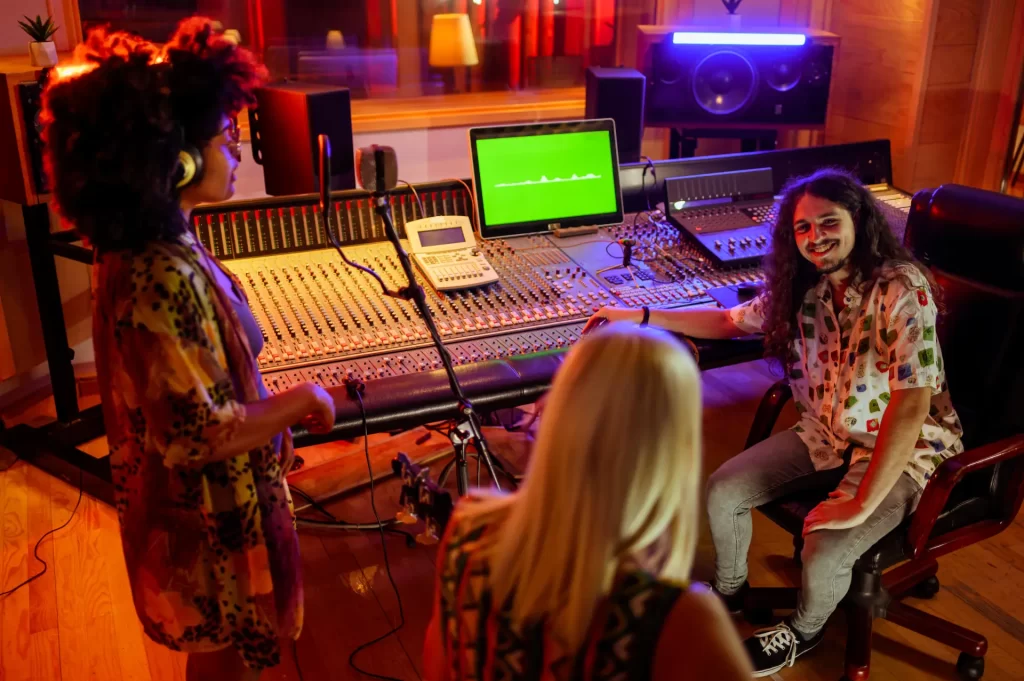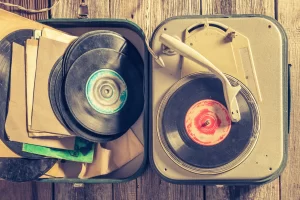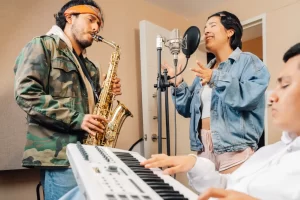Building a home recording studio is an exciting step for any musician or audio enthusiast. With the right home studio essentials, you can create high-quality music without ever leaving the comfort of your own space. Whether you’re recording vocals, mixing tracks, or experimenting with instruments, a well-equipped home studio can make all the difference in your production quality.
In this guide, we’ll cover everything you need to know about setting up a music recording studio at home, from selecting the perfect room to choosing the must-have equipment. Whether you’re working with a budget or looking to upgrade your setup for professional results, we’ve got you covered.
We’ll break down the key components, such as audio interfaces, microphones, studio monitors, and DAW software, while also touching on acoustic treatment to ensure your sound is clean and clear. By the end of this post, you’ll have a solid understanding of what it takes to build a functional, productive home studio.
Get ready to turn your musical ideas into reality by creating the perfect environment for your recordings with these home studio essentials. Let’s dive in and start building the home recording studio of your dreams!
Choosing the Right Space for Studio
Selecting the right space is one of the most crucial steps in building your home recording studio. The room you choose can significantly impact the quality of your recordings. Ideally, you want a room with minimal external noise, good acoustics, and enough space to comfortably fit your home studio essentials.
Start by picking a location away from busy areas of your home. Basements, attics, or spare rooms are excellent options because they tend to have fewer distractions. Make sure to avoid rooms with too much natural echo or reverb, like large, empty spaces or rooms with hard surfaces such as tile floors.
Soundproofing is another important factor. While you may not need professional-grade soundproofing, adding some basic acoustic treatment like foam panels or thick curtains can go a long way in preventing outside noise from entering your studio. Consider placing a rug or carpet on the floor to reduce sound reflection.
Lastly, layout is essential for workflow. Ensure the room has enough outlets for your recording equipment, and organize the space so that your studio monitors, microphones, and audio interface are within easy reach. By choosing the right space, you’ll set the foundation for a functional and productive home studio.
Must-Have Home Studio Essentials
Building a high-quality home recording studio starts with gathering the right home studio essentials. Whether you’re a beginner or an experienced musician, having the right equipment ensures professional results from the comfort of your home.
First, invest in a good audio interface. This device is the backbone of your studio, connecting your instruments and microphones to your computer while converting analog signals to digital ones. Popular options include Focusrite Scarlett or Universal Audio Apollo.
Next, you’ll need a reliable microphone. For versatile use, consider a condenser microphone, which works well for vocals and acoustic instruments. The Audio-Technica AT2020 is a great option for beginners, offering excellent sound at an affordable price.
Studio monitors and headphones are also essential for accurate sound playback. Studio monitors like KRK Rokit or Yamaha HS Series provide flat frequency responses, helping you hear true sound. Complement them with high-quality headphones like the Audio-Technica ATH-M50x for precise listening.
You’ll also need a powerful computer and DAW (Digital Audio Workstation) software to handle recording and mixing. Popular DAWs include Ableton Live, FL Studio, and Logic Pro.
With these must-have home studio essentials, you’ll be well-equipped to produce professional-level recordings right from your home.
Home Studio Acoustic Treatment
When it comes to building the perfect home recording studio, acoustic treatment is essential. Without proper treatment, even the best home studio essentials won’t deliver professional-quality sound. Acoustic treatment helps manage the way sound behaves in your room, minimizing unwanted reflections, echoes, and background noise.
Start by addressing the most critical areas—walls, ceiling, and corners. Acoustic foam panels are a cost-effective way to absorb sound and reduce echoes. Install them on the walls where sound waves are most likely to reflect. Corners are another trouble area for bass frequencies, so adding bass traps helps balance the low-end response of your recordings.
Diffusers are useful for breaking up sound waves to prevent harsh echoes, creating a more balanced listening environment. For musicians on a budget, DIY options like hanging thick blankets, curtains, or rugs on hard surfaces can also improve sound quality.
While soundproofing (preventing sound from entering or leaving the room) is different from acoustic treatment, it’s a good idea to address both. Simple solutions, such as adding weatherstripping around doors and windows, can help block outside noise from interfering with your recording.
Investing in proper home studio acoustic treatment ensures that your recordings will be clean, clear, and professional, no matter your gear.
Home Studio Setup on a Budget
Building a professional-quality home recording studio doesn’t have to break the bank. You can create an effective setup with the right home studio essentials while keeping costs low. Here’s how to optimize your home studio setup on a budget.
Start with the basics: an affordable audio interface like the Focusrite Scarlett Solo or PreSonus AudioBox can give you excellent performance without a high price tag. These entry-level interfaces offer solid sound quality and are easy to set up, making them ideal for beginners.
For microphones we mentioned the Audio-Technica AT2020, it’s a great budget-friendly condenser mic that delivers professional sound for vocals and acoustic instruments. Alternatively, the Shure SM57 is a versatile and durable dynamic mic that works well for recording instruments.
When it comes to studio monitors, consider budget options like the Mackie CR Series or JBL 305P, which provide good sound clarity for mixing without the hefty price. Pair these with affordable closed-back headphones like the Audio-Technica ATH-M20x for accurate monitoring.
To save on acoustic treatment, use DIY solutions like foam mattress toppers, thick blankets, or rugs to reduce reflections and improve sound quality. Free or low-cost DAW software options like GarageBand or Audacity are perfect for basic recording and mixing.
With smart choices, you can set up a functional and affordable home studio on a budget.
Advanced Gear for Professional Results
As you progress in your music production journey, upgrading to advanced home studio gear can significantly enhance the quality of your recordings and mixes. While the basics are enough to get you started, investing in higher-end equipment will give you more control and produce professional-level results.
One key upgrade is a high-quality audio interface with more inputs and outputs, like the Universal Audio Apollo or RME Babyface Pro. These interfaces offer superior sound conversion and low latency, giving you a cleaner, more detailed sound.
Consider adding a preamp for richer, more polished recordings. A preamp like the Focusrite ISA One or Warm Audio WA12 can bring warmth and depth to your vocals and instruments. For more control over your sound, you might also want to invest in outboard compressors or EQ units, like the dbx 160A or Warm Audio EQP-WA.
Upgrading your studio monitors to models like the Yamaha HS8 or Genelec 8030 will give you more accurate sound reproduction, helping you create better mixes. For mastering your tracks, consider adding mastering plugins or hardware to ensure your final product sounds polished.
Investing in advanced home studio gear allows you to produce professional-level recordings right from your home, whether you’re recording music or mixing tracks for clients.
Home Studio Essentials Checklist
Creating a home recording studio requires gathering the right home studio essentials to ensure you have everything you need for high-quality recordings. Whether you’re a beginner or an experienced producer, this checklist will help you assemble the core components for a functional studio.
- Audio Interface: The heart of your studio, connecting your instruments and microphones to your computer. Options like the Focusrite Scarlett or PreSonus AudioBox are great starting points.
- Microphone: A versatile condenser microphone like the Audio-Technica AT2020 is ideal for capturing vocals and instruments with clarity.
- Studio Monitors: Accurate sound playback is key. Affordable options include Mackie CR Series or Yamaha HS5 for clear and balanced sound.
- Headphones: For precise monitoring, invest in a good pair of closed-back headphones, such as the Audio-Technica ATH-M50x or Sennheiser HD 280 Pro.
- DAW (Digital Audio Workstation) Software: Choose a DAW that fits your needs. Popular options include Ableton Live, Logic Pro, or FL Studio.
- MIDI Controller: Essential for composing and arranging music, the Akai MPK Mini is a compact and affordable option.
- Acoustic Treatment: Use foam panels, bass traps, or DIY solutions like thick curtains to control sound reflections.
- Cables and Stands: Don’t forget essential accessories like XLR cables, pop filters, and microphone stands.
With this home studio essentials checklist, you’ll be fully equipped to start creating professional-quality music right from your home.
To Sum It Up
Building a home recording studio is a rewarding and creative process that allows you to produce high-quality music right from your own space. With the right home studio essentials—including a solid audio interface, quality microphones, studio monitors, and DAW software—you can create a professional setup on any budget.
Choosing the right space, incorporating proper acoustic treatment, and making strategic gear upgrades as your skills improve are crucial steps to achieving the best sound possible. Whether you’re a beginner or looking to enhance your existing setup, the key is to start with the essentials and expand as your needs grow.
Remember, you don’t have to spend a fortune to get great results. With budget-friendly options and DIY solutions, you can build a home studio that works for you while still producing polished, professional recordings. As you grow more familiar with your equipment and the recording process, you can explore more advanced gear to take your music to the next level.
So, whether you’re recording your first track or fine-tuning a professional mix, these home studio essentials will help you create the ideal environment for your music production journey. Now, it’s time to bring your creative vision to life!




